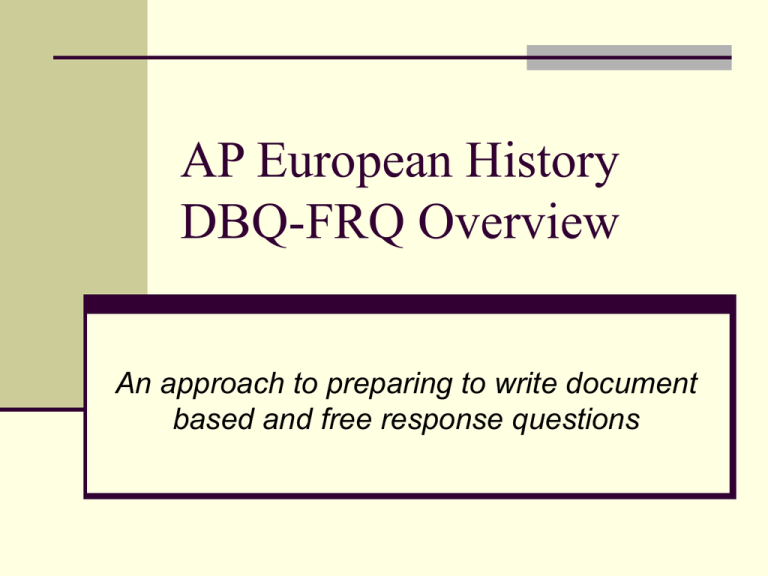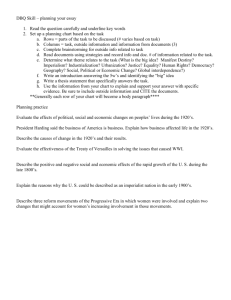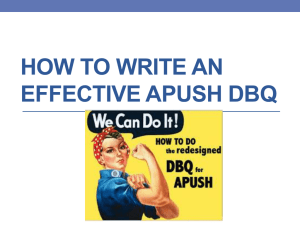Writing a DBQ Ppt - T
advertisement

AP European History DBQ-FRQ Overview An approach to preparing to write document based and free response questions Advanced Placement Expectations Write at least 4 full pages. Write in past tense – different from English! A timed writing means that you need to complete in the time allotted. Watch the clock! Of the 130 minutes for writing, 15 are mandatory for the reading of the DBQ documents, 45 for the DBQ and 35 for each of the two FRQ’s. You can only be graded on what you actually write – never assume anything. Approaching the DBQ Dissect the prompt – annotate key parts and clues. Read the documents – annotate/begin groupings. Make tentative groups – write in the test booklet. Write the rubric in the test booklet so the reader sees that you know what you are suppose to do: ~1. Clear thesis ~2. Use all documents (OK to miss one only) ~3. Understand the meaning (OK to miss one only) ~4. Use DOC’s to support thesis ~5. Identify POV = Point of View and bias in the DOC’s ~6. Group documents see similarities – Need four groups; three DOC’s to a group Clues in the prompt Analyze – examine in detail; discuss relationships. Assess the validity – judge the value or truth of. . . Contrast/compare – differences AND similarities Defend – argue in favor of. . . Describe – Tell about Discuss – consider various points of view Evaluate – judge the worth; advantages and disadvantages Explain – provide meaning, cause, make the subject clear Identify – cite specifics; explain relationships Refute – argue against. . . To what extent and in what ways – how and how much? Grouping the documents NOTE: Write about each document individually and specifically GROUP #1 (Identify it) doc #3 a) Attribute (who wrote it?) b) Reason (why it was written i.e. newspaper, diary, etc.) c) POV (what is the writer’s motive or bias?) doc #5 a) Attribute b) Reason c) POV GROUP #2 (Identify it) doc #8 a) Attribute b) Reason c) POV And so on. . . Typical DBQ Groupings a. For/ good b. Against/ bad c. Occupation d. Religion e. Outsider/Foreigner f. Nationality Use all of the documents (11/12 is OK) Need four groupings (some may be in two) DO NOT CLUMP (deal with each individually) Watch for the change over time question! Rules for success on the DBQ #1 Write the grading rubric in the booklet #2 Memorize and follow the grading rubric #3 Look for clues in the prompt #4 Write at least 4 pages (2 pages front/back) #5 Make it easy for the reader by: ~identifying all DOCS (DOC 1) ~listing all DOCS in the margin where used #6 Always attribute the author of the DOC #7 Give background/ POV #8 Watch the clock #9 Give outside information if at all possible Approaching the FRQ Select the essay you know the most about. Don’t lose time by agonizing over the choice. Analyze the question/prompt. What is being asked? Brainstorm and be deliberate in planning each paragraph. Use topic sentences to transition your ideas. Use a specific/clear thesis. More of a “statement of organization”. Your thesis paragraph tells the reader how much you know about the subject. It should be big, filled with details and front-loaded. No less than three body paragraphs. Keep it simple and direct. Do not abandon grammar, spelling and style. Conclusion that states what your evidence has proven. Finish the essay with a series of sentences that explains something important about the time period and how your ideas relate an important idea about history in general. An essay that does not do what they ask will not do well. Sample FRQ choice Choose ONE question from this group. The suggested writing ime for this question is 30 minutes. You are advised to spend 5 minutes planning your answer in the area below. 1. Machiavelli suggested that a ruler should behave both “lie and lion” and “like a fox.” Analyze the policies of TWO of the following European rulers, indicating the degree to which they successfully followed Machiavelli’s suggestion. Choose two: Elizabeth I of England, Henry IV of France, Catherine the Great of Russia, Frederick II of Prussia. 2. Discuss the relationship between politics and religion by examining the wars of religion. Choose TWO specific examples for the following: Dutch Revolt, French Wars of Religion, English Civil War, Thirty Years’ War. 3. Compare and contrast the degree of success of treaties negotiated in Vienna (1814-1815) and Versailles (1919) in achieving European stability. The reader’s 80 second crunch The Thesis Answer the question specifically and completely. Your thesis is your roadmap which can be one-to-three sentences. This thesis statement is generally considered a “statement of organization”, listing what you will prove about that claim. The thesis paragraph must be impressive; packed with information that shows how much you know about the subject of the question. The first paragraph must cover ALL aspects of the question. Don’t try to be too clever. Be deliberate and straight forward. Practicing the Thesis Working in a group of three, take out a sheet of paper and put your name at the top. Create a DBQ or FRQ essay PROMPT. Exchange papers to the right. Write a thesis for the prompt you have received. Fold the paper so that only your thesis statement is visible. Exchange papers to the right again. Read the thesis statement carefully and write the question that you think the thesis statement has responded to. Did you match?





